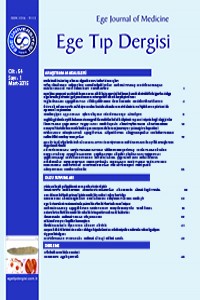Öz
Aim: In this study, it was aimed to investigate the possible histological changes in the ovarian structure and particularly in the oocytes, cumulus cells and granulosa cells containing thyroid hormone receptors, tissue regeneration capability and capacity in terms of stem cell markers immunohistochemically by experimentally-induced thyrotoxicosis in rats. Materials and Methods: Two study groups were formed (eight rats for each group); 500μgr/kg/day 3,3',5-Triiodo-L- thyronine was injected intraperitoneally to female rats in thyrotoxicosis group during ten days. In 11th day, all animals were anesthesized, 5 cc blood was drawn for biochemical evaluation and then all were decapitated in order to remove ovaries. Ovaries were placed in 4% paraformaldehyde fixative for immunohistochemical investigation. Immunohystochemical processing and staining were performed routinely and all samples were evaluated by light microscopy. Results: As a result of immunohistochemical staining, c-kit and Thy-1 expressions were found to be significantly decreased in the thyrotoxicosis group compared with the control group, whereas Nanog expression was increased in the thyrotoxicosis group. Decrease in c-kit and Thy-1 expression in the thyrotoxicosis group caused a reduction in the stimulatory effects of the growth factors on oocytes, cumulus and granulosa cells. Conclusion: Decreased levels of c-kit and Thy-1 in rat model of thyrotoxicosis lead to a decrease in stromal growth support and deterioration of microenvironment. Elevated levels of Nanog expression in thyrotoxicosis was interpreted as an effort to protect the microenvironment for the sake of follicles and oocytes despite the increase in catabolic processes (as a result of increased metabolism in almost all cells due to thyroid hormones).
Anahtar Kelimeler
Öz
Amaç: Bu çalışmada, deneysel olarak tirotoksikoz oluşturulan sıçanlarda, tirotoksikoza bağlı olarak ovaryum yapısında, özellikle tiroid hormon reseptörleri içeren oosit, kumulus hücreleri ve granülosa hücrelerinde oluşabilecek histolojik değişimler ile doku rejenerasyon yeteneği ve kapasitesinin, kök hücre belirteçleri açısından immünohistokimyasal olarak araştırılması amaçlandı. Gereç ve Yöntem: Her biri 8 sıçandan oluşan 2 çalışma grubu oluşturuldu. Tirotoksikoz grubu dişi sıçanlara 10 gün intraperitoneal 500μgr/kg/gün 3,3',5-Triiodo-L-thyronine enjekte edildi. On birinci gün tüm hayvanlara anestezi uygulandı, biyokimyasal değerlendirmeler için 5 cc kan alındıktan sonra dekapite edilerek ovaryumları çıkarıldı. Ovaryumlar immünohistokimyasal incelemeler için %4'lük paraformaldehit fiksatifi içine alındı. Rutin immünohistokimyasal takip ve boyamalar yapılarak tüm örnekler ışık mikroskobunda değerlendirildi. Bulgular: İmmünohistokimyasal boyamalar sonucunda c-kit ve Thy-1 ekspresyonu kontrol grubuna göre tirotoksikoz grubunda belirgin düzeyde azalmış, Nanog ekspresyonu ise tirotoksikoz grubunda artmış olarak bulundu. Tirotoksikozlu sıçanlarda c-kit ve Thy-1'in azalması, tirotoksikozda stromal büyüme desteğinin azalmasına ve mikroçevre bozunumuna neden oldu. Sonuç: Tirotoksikozda Nanog ekspresyonunun artışı, foliküler yapıları ve oositleri korumak adına dokunun katabolik süreç (tiroid hormonlarının hemen tüm hücrelerde metabolizmayı hızlandırmasına bağlı olarak) artışına rağmen reaktif olarak mikroçevreyi koruma çabası olarak yorumlandı.
Anahtar Kelimeler
Ayrıntılar
| Diğer ID | JA82RE42NN |
|---|---|
| Bölüm | Araştırma Makaleleri |
| Yazarlar | |
| Yayımlanma Tarihi | 1 Mart 2015 |
| Gönderilme Tarihi | 1 Mart 2015 |
| Yayımlandığı Sayı | Yıl 2015 Cilt: 54 Sayı: 1 |
Ege Tıp Dergisi, makalelerin Atıf-Gayri Ticari-Aynı Lisansla Paylaş 4.0 Uluslararası (CC BY-NC-SA 4.0) lisansına uygun bir şekilde paylaşılmasına izin verir.

